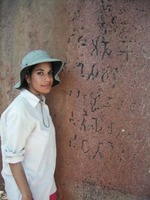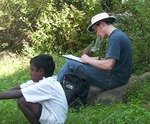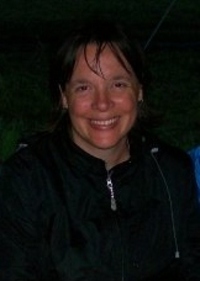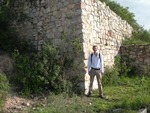 Enrique Rodríguez-Alegría. I am currently Associate Professor in the Department of Anthropology at the University of Texas at Austin. My interests include colonialism, materiality and power, political economy, and technology. These interests have converged in two main lines of research. First, I study in the relationship between power struggles and cultural change, specifically in the ways in which material culture is involved in processes of colonialism and empire-building. Second, I research technology and the ways that the political economy can affect processes of technological change. My empirical work is a combination of archaeology, ethnohistory, and archaeometry, and it focuses on central Mexico, especially during the Aztec era and the early Colonial period. I have worked in Mexico City at the Templo Mayor Museum, Xaltocan, and Tula. http://www.utexas.edu/cola/depts/anthropology/faculty/err236
Enrique Rodríguez-Alegría. I am currently Associate Professor in the Department of Anthropology at the University of Texas at Austin. My interests include colonialism, materiality and power, political economy, and technology. These interests have converged in two main lines of research. First, I study in the relationship between power struggles and cultural change, specifically in the ways in which material culture is involved in processes of colonialism and empire-building. Second, I research technology and the ways that the political economy can affect processes of technological change. My empirical work is a combination of archaeology, ethnohistory, and archaeometry, and it focuses on central Mexico, especially during the Aztec era and the early Colonial period. I have worked in Mexico City at the Templo Mayor Museum, Xaltocan, and Tula. http://www.utexas.edu/cola/depts/anthropology/faculty/err236
 Namita Sugandhi. My earlier dissertation work was on the Mauryan empire and its relationship to the Southern Deccan in peninsular India. I am currently working on a field project in southeastern Rajasthan that examines questions about long term interregional interaction and issue of site preservation and heritage management in rural South Asia. My research interests include the study of sovereignty in South Asia, non-territorial models of early states, decolonized strategies of archaeological practice and the integration of archaeological and textual records. I am a Lecturer at Indiana University Northwest.
Namita Sugandhi. My earlier dissertation work was on the Mauryan empire and its relationship to the Southern Deccan in peninsular India. I am currently working on a field project in southeastern Rajasthan that examines questions about long term interregional interaction and issue of site preservation and heritage management in rural South Asia. My research interests include the study of sovereignty in South Asia, non-territorial models of early states, decolonized strategies of archaeological practice and the integration of archaeological and textual records. I am a Lecturer at Indiana University Northwest.
namitasugandhi@gmail.com
 Andrew Bauer. My dissertation research examined Iron Age (1200-300 BC) land use and settlement patterns in the environs of Kadebakele, a large settlementsituated on the Tungabhadra River in Karnataka, South India. In this project, I combined archaeological survey with multi-spectral remote sensing and sediment, soil, and pollen analyses. Using these diverse datasets, I demonstrated that a series of environmental “objects” (e.g., rock pools, soil distributions, inselberg features) that are widely believed to be natural landscape elements were created during the Iron Age as a means of appropriating space for politically instrumental ritual activities and agro-pastoral production. As a follow-up to this research, I am currently carrying out an archival project on British colonial geology, which would come to understand South India's more recent landscape features without considering anthropogenic formation processes. At the same time, I am planning to return to the field to continue documenting the historical ecology of northern Karnataka, with particular emphasis on the transition from Iron Age political configurations to the early dynastic polities of South India. I am an Assistant Prfoessor at the University of Illinois.
Andrew Bauer. My dissertation research examined Iron Age (1200-300 BC) land use and settlement patterns in the environs of Kadebakele, a large settlementsituated on the Tungabhadra River in Karnataka, South India. In this project, I combined archaeological survey with multi-spectral remote sensing and sediment, soil, and pollen analyses. Using these diverse datasets, I demonstrated that a series of environmental “objects” (e.g., rock pools, soil distributions, inselberg features) that are widely believed to be natural landscape elements were created during the Iron Age as a means of appropriating space for politically instrumental ritual activities and agro-pastoral production. As a follow-up to this research, I am currently carrying out an archival project on British colonial geology, which would come to understand South India's more recent landscape features without considering anthropogenic formation processes. At the same time, I am planning to return to the field to continue documenting the historical ecology of northern Karnataka, with particular emphasis on the transition from Iron Age political configurations to the early dynastic polities of South India. I am an Assistant Prfoessor at the University of Illinois.
Byron Hamman. I study prehispanic Mesoamerica, Catholicism and Islam in late medieval Europe, and the intersection of these traditions in the early modern transatlantic world. My work in historical ethnography draws on alphabetic documents as well as other kinds of material records: images, objects, landscapes, buildings, archaeological remains. For my doctoral project, I conducted over three years of archival research in both Mexico and Spain. The dissertation centers on two inquisitorial investigations which began in the 1540s. One is from Spain (Valencia), and the other from Mexico (Oaxaca). The first involves relations between Muslims and Catholics, and the second relations between Native Americans and Europeans. The different testimonies given (by religious specialists, nobles, former slaves) create a complex picture of social life in both Valencia and Oaxaca. Alliances and enmities, for example, commonly cross religious and ethnic divisions. For a broader perspective, I supplement the words of witnesses with documents from non-inquisitorial sources (Islamic legal rulings, prehispanic books, notary archives) as well as other types of material traces. Overall, the project involves microhistories of two specific places, and at the same time looks for parallels between the internal colonization of Muslims in Valencia and the external colonization of Native Americans in the New World. I am an Assistant Professor of Art History at Ohio State University.
 Laura Popova. I am a Senior Lecturer and chair of the Honors Faculty at Barrett Honors College, Arizona State University. My research focuses on the politics of pastoral land use, past and present, in Central Asia and Russia. I am interested in studying the ways in which political, ecological, and cultural orders of pastoral societies shape and restructure global and local environments. I have conducted most of my research in the Samara province of Russia, examining the ways in which shifting land use, vegetation use, and settlement strategies indicate changing political and economic realities over the course of the Bronze Age (approximately 3000-800 BCE). Recently, I conducted a survey with my Russian colleagues of the Spiridonovka region in Samara River Valley as part of larger project called "The Samara River Valley Political Ecology Project."
Laura Popova. I am a Senior Lecturer and chair of the Honors Faculty at Barrett Honors College, Arizona State University. My research focuses on the politics of pastoral land use, past and present, in Central Asia and Russia. I am interested in studying the ways in which political, ecological, and cultural orders of pastoral societies shape and restructure global and local environments. I have conducted most of my research in the Samara province of Russia, examining the ways in which shifting land use, vegetation use, and settlement strategies indicate changing political and economic realities over the course of the Bronze Age (approximately 3000-800 BCE). Recently, I conducted a survey with my Russian colleagues of the Spiridonovka region in Samara River Valley as part of larger project called "The Samara River Valley Political Ecology Project."
Krista Lewis. Associate Professor of Anthropology, University of Arkansas.
Michelle Lelievre. Assistant Professor of Anthropology and American Studies, William and Mary.
Peter Gavin Johanson. Postdoctoral Research Associate, University of British Columbia
